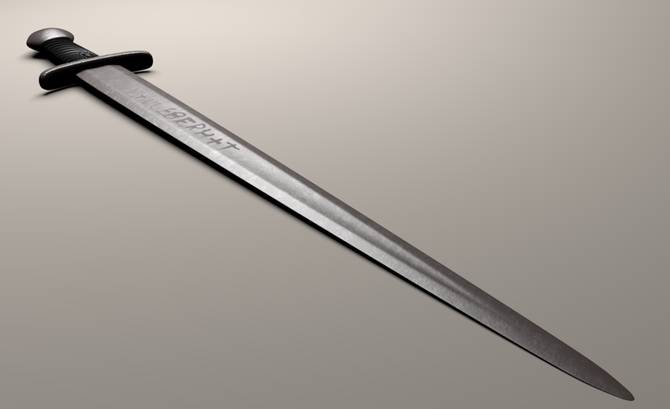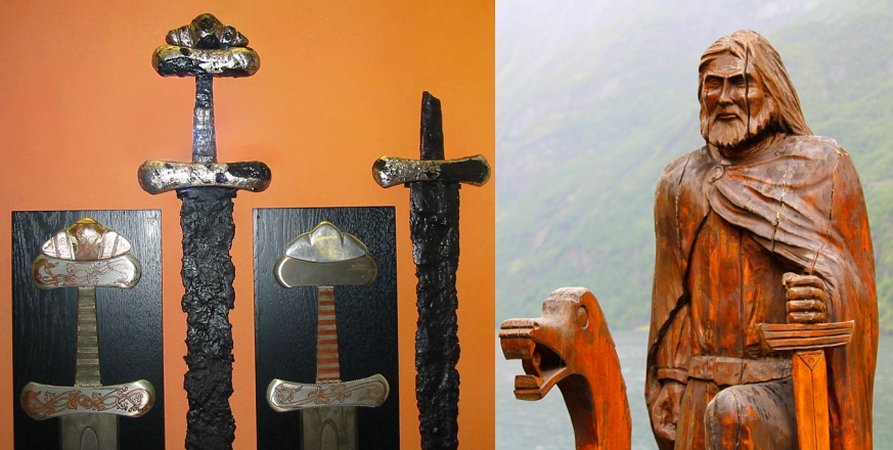Ellen Lloyd - AncientPages.com - The loss of a sword was a catastrophe to a Viking. Vikings believed a man and his sword were bound together. The sword gave power to the warrior, but warrior's strength could also be transferred to the sword.
A Viking sword was a deadly weapon and symbol of power. It was jewelry for a man, with 'magical properties'. How the Vikings named their sword was a matter of heritage. Swords were given names and passed from father to son for generations.
Swords were extremely important to ancient Vikings, but these weapons were expensive to produce and only the richest warriors and chiefs could afford a sword.
Sometimes, Vikings carried decorated swords that were useless in battles. According to scientists, such Vikings swords covered with beautiful decorations became symbols of power and status and they were almost never used because they were never designed for combat. As the role of swords changed in the Viking society, these ‘weapons’ simply became decorative clothing accessories.
That a Viking could kill with a real sword is well-known, but just how effective were these weapons really?

Unravelling The Mystery Of The Ulfberht Sword - An Ancient Viking Artifact Far Ahead Of Its Time - read more
Viking swords were undoubtedly impressive, but researchers have discovered their effectiveness varied because of the iron quality.
During the late Iron Age and Viking Age, iron was not just iron but a material of many qualities.
According to Science Nordic, “unlike modern iron, all iron produced in the past contained slag—a waste product created during the production process.
Old iron extraction processes were not particularly effective, and never really reached the temperature at which iron and slag are entirely separated.
The tiny pieces of slag inside the iron were trapped during the reduction process and then when the bloom iron was beaten into iron pieces and forged into a sword.
See also:
Mighty King Harald Hardrada- The Last Great Viking And Most Feared Warrior Of His Time
Holmgang – Dangerous Viking Duel Settled Disputes
Glima – Ancient Martial Art Practiced By The Vikings Is Still Popular Today
Ivar The Boneless: Famous Viking And Son Of Ragnar Lodbrok
Working with this material required extensive experience, as the small pieces of slag gradually worked their way up to the surface with each strike of the blacksmith’s hammer.
If this happened during a critical stage in the manufacturing process it could have a devastating effect on the sword quality, while also disfiguring the swords overall appearance.”
However, seventh century blacksmiths were very talented, drawing on more than a thousand years’ experience of working with slag-rich iron.
Viking blacksmiths used a technique “combining pure iron for the middle of the blade and steel along the edges.
The single edged sword from the late Iron Age and the double edged sword from the Viking Age. The swords were not only a different shape, one of them was longer and much broader.
The steel often contained just a few, flat pieces of slag, indicating that it had been worked over a longer time than the pure iron. These craftsmen cared about the sword’s appearance, but also its effectiveness in battle.
The difference is in no way insignificant.
Comparing a sword made of pure iron with one edged in steel is like comparing a propeller airplane with an F16 fighter jet.
An Iron Age warrior could still cut and stab with his sword, but the Viking’s steel-edged sword was much more effective.”
Ancient Secrets Of The Damascus Steel – Legendary Metal Used By Crusaders And Other Warriors - read more
Of course, Viking swords were by no means as effective as the legendary swords used by Crusaders. These swords were made of Damascus steel, a metal that could slice a hair in half in mid-air, and yet it was strong enough to strike fear into even the most brave and persistent warrior.
Knowledge of the legendary metal spread and it became known to the Europeans as the Damascus steel, named after the capital of Syria. Sometime in the 18th century, the formula for Damascus steel was lost and the original method for producing the Damascus steel remains an ancient secret.
Witten by Ellen Lloyd - AncientPages.com






